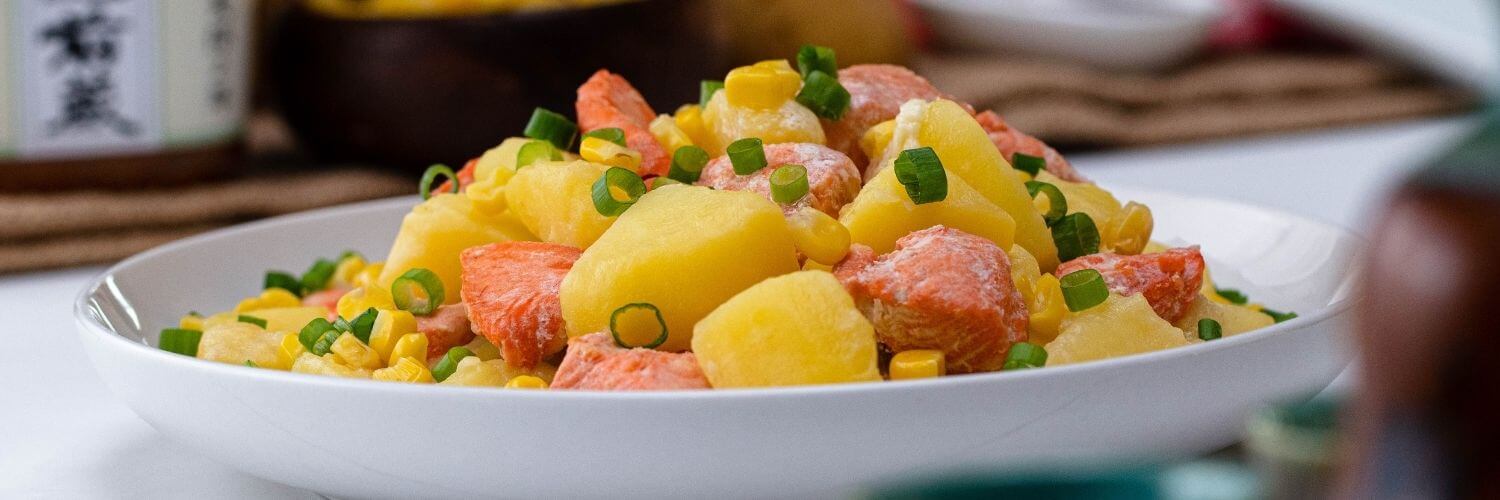
Using high-quality Two-Year Fermented Miso from Japan, we will show you how to create a flavor-rich salmon and potato stew perfect for the winter-time. Full of umami flavor and warming to the soul, this is comfort food that will please the entire dinner party.
Are you feeling the winter blues? Warm yourself up with this hearty potato and salmon miso butter stew! This Japanese recipe is a cold season favorite and will draw applause from family, friends, and other dinner guests. In this recipe, we have included recommendations for high-quality ingredients so that your dish has the real umami-rich flavor that makes all the difference! Healthy and filling, this potato and salmon with miso butter dish will soon become one of your favorite go-to recipes.
How is Two Year Fermented Miso Different from Other Miso?
We recommend using this top-quality artisan Two-Year Fermented Miso. Crafted by Kyoichi Nakata, who also invented the first non-additive miso in Japan, this miso proudly exhibits the distinctive, ancient bold flavors of salty and rich umami. To make this miso, a two-year process of fermentation is undertaken.You will easily realize the significant difference in the flavor of this miso compared to other mass-produced miso pastes
Other Kinds of Miso
Miso is basically fermented soybean paste, but it’s far from being a simple ingredient. In fact, in Japanese food culture, there are many different kinds of miso. The most common type of miso is called Awase. Awase miso is known as blended miso because it is made from both white and red misos. Soybean miso is known as red miso in Japan and has a strong flavor because it is aged longer. It is usually used in small amounts added to soups or other dishes to give it an umami punch.
Rice miso is called white miso, or Saikyo miso. It is lighter and sweeter than most other types of miso. Barley miso, also known as yellow miso, is somewhere between red and white miso in terms of flavor intensity and sweetness. It is not as commonly used as other types of miso in most of the country but has popularity in provinces like Kyushu and Shikoku.
How to Store Miso
If you store your miso correctly, it will keep for a year or longer. The best way to do this is to cover it after opening it with a plastic sheet to keep the air out. Then either refrigerate or freeze it. Miso will not harden in a standard kitchen freezer. So you will be able to scoop out whatever you need when you want to without defrosting it. Most miso should be labeled with a use-by date. However, you should also smell the miso before you use it, and if it smells off, it should not be consumed.
Miso Butter Recipe Cooking Tips:
- You can easily substitute salmon with any other protein that you would like.
- Eat this salmon and potato stew with a hot bowl of white rice, dip crunchy bread to the soup, or add noodles to make a “miso ramen-ish” dish!
Potato & Salmon with Miso Butter

Ingredients
- 4 Yellow Potato
- 2 fillet Salmon
- 1 Tbsp Sake
- ¼ tsp Salt
- 1 tsp Soy Sauce
- 1 tsp Sugar
- 1 tsp Dashi Powder
- 1 ½ cup Water
- ½ cup Milk
- 1 Tbsp Miso
- 1 Tbsp Butter
- 2 Tbsp Cooked Corn, for garnishing
- Scallions, for garnishing
Instructions
- Cut salmon fillet into bitable pieces and mix with sake and salt.
- Peel potatoes and cut into bitable pieces.
- In a pot, place potatoes, soy sauce, sugar, dashi powder, and water and bring to boil over medium heat
- Once boiled, reduce heat to low. Place a drop lid and simmer until potatoes are tender, about 10 minutes.
- Remove the lid and add salmon filet to the pot. Cook for 3-4 minutes and stop the heat.
- Add one tablespoon of miso and melt. Turn the heat to medium and add milk. Cook until salmon is done.
- Plate the potato and salmon. Sprinkle corn and scallions. Place butter on top and melt, enjoy!
